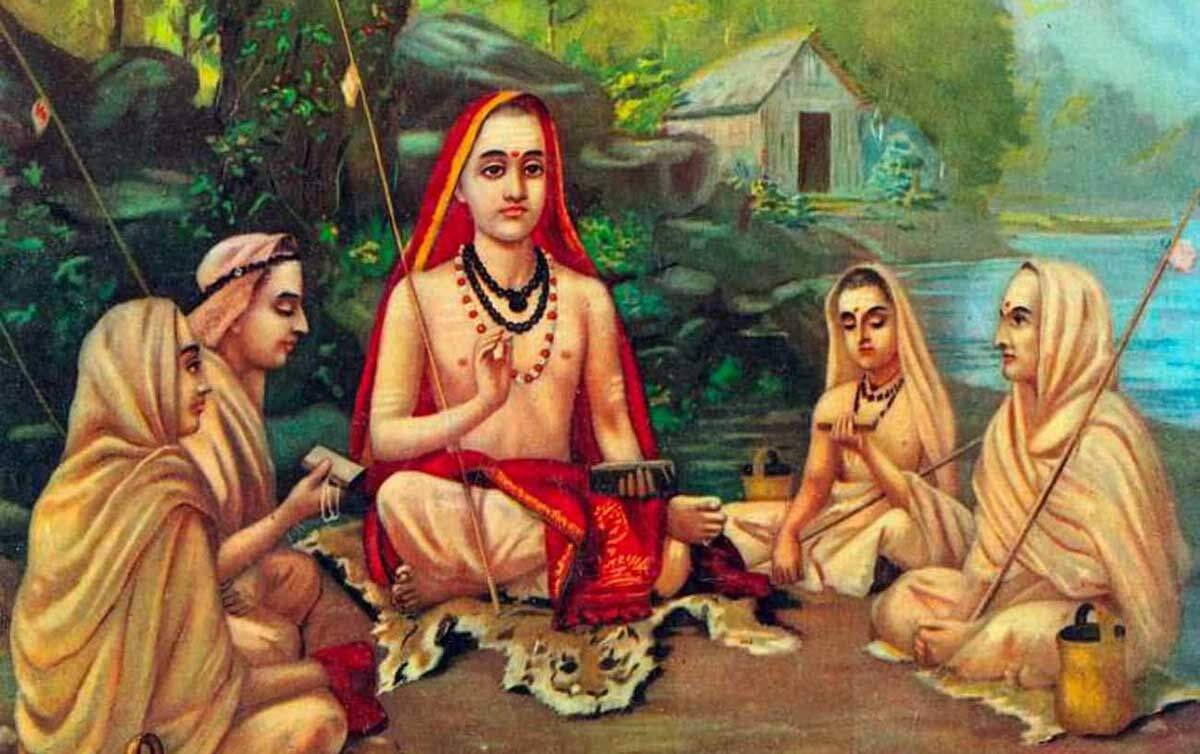The philosophy of Advaita Vedanta, a sub-school of Vedanta, is rooted in the Upanishads, the final sections of the Vedic texts. Often translated as “not two,” Advaita Vedanta articulates a non-dualistic perspective on reality, asserting the fundamental unity of the self (Atman) and the ultimate reality (Brahman) (Jacobsen, 2011).
Adi Shankaracharya, a pivotal 8th-century Indian philosopher, is credited with consolidating the doctrine of Advaita Vedanta. His interpretations of the Upanishads, Bhagavad Gita, and Brahma Sutras elucidate this philosophy’s core tenets (Mayeda, 2006).
Atman and Brahman: The Essence of Advaita Vedanta
Advaita Vedanta maintains that Atman and Brahman are identical, and that the realization of this unity leads to liberation (Moksha). The Brahman is the ultimate reality – infinite, eternal, unchanging, and formless. At the same time, Atman, the individual self, is also fundamentally Brahman. However, this truth is obscured by ignorance (Avidya), which leads to the perception of duality, the illusion of separate selves, and the material world (Maya) (Dasgupta, 1992).
Maya: The Veil of Illusion
Maya, in Advaita Vedanta, is the cosmic illusion that makes the phenomenal world appear real. It is not unreal, as it exists and affects human perceptions and actions, but it is not ultimate reality either. Maya veils Brahman, leading individuals to identify with the body and mind instead of realizing their true nature as Brahman. Overcoming Maya, therefore, is key to achieving Moksha (Deutsch, 1969).
Moksha: The Ultimate Liberation
Moksha, the highest goal in Advaita Vedanta, is liberation from the cycle of birth and death (Samsara). It is achieved through the realization of the identity of Atman and Brahman. Moksha entails a direct, experiential knowledge (Jnana) that one’s true self is not different from the ultimate reality. This realization dissolves the illusory distinctions and liberates one from suffering and the cycle of rebirth (Rambachan, 1991).
The Path to Liberation
Advaita Vedanta advocates the path of Jnana Yoga, the yoga of knowledge, as the primary means to Moksha. This path involves a deep study of Vedantic texts, contemplation, meditation, and guidance from a qualified teacher (Guru). The practice of Karma Yoga, the yoga of selfless action, and Bhakti Yoga, the yoga of devotion, are also seen as conducive to preparing the mind for the realization of non-duality (Sharma, 2000).
While Advaita Vedanta’s philosophical constructs are abstract and metaphysical, its influence on Indian spirituality, as well as its resonance in Western philosophical and spiritual discourses, is profound. The non-dualistic perspective it offers, where the ultimate reality and the self are not two separate entities but one unified whole, provides a unique lens through which we can examine the nature of existence and the self. The philosophy’s focus on liberation and self-realization continues to inspire spiritual seekers worldwide, affirming its timeless relevance and universal appeal.
Advaita Vedanta’s teachings have far-reaching implications for understanding the nature of reality, consciousness, and the ultimate purpose of human life. Its vision of the innate divinity of all beings and the unity of existence has the potential to shape ethical perspectives and foster a sense of interconnectedness. Indeed, in an increasingly fragmented world, the philosophy of Advaita Vedanta can offer insights for cultivating unity, compassion, and a deeper understanding of our shared humanity.
References
- Dasgupta, S. (1992). A History of Indian Philosophy (Vol. 1). Cambridge University Press.
- Deutsch, E. (1969). Advaita Vedanta: A Philosophical Reconstruction. University of Hawaii Press.
- Jacobsen, K. A. (2011). Theories and Philosophical Positions in the Classical Indian
- Traditions of Yoga and Vedanta. In E. Bryant & M. Ekstrand (Eds.), The Yoga Tradition of the Mysore Palace (pp. 79-98). New Delhi: Abhinav Publications.
- Mayeda, S. (2006). A Thousand Teachings: The Upadesasahasri of Sankara. Motilal Banarsidass.
- Rambachan, A. (1991). Accomplishing the Accomplished: The Vedas as a Source of Valid Knowledge in Sankara. University of Hawaii Press.
- Sharma, C. (2000). A Critical Survey of Indian Philosophy. Motilal Banarsidass.
